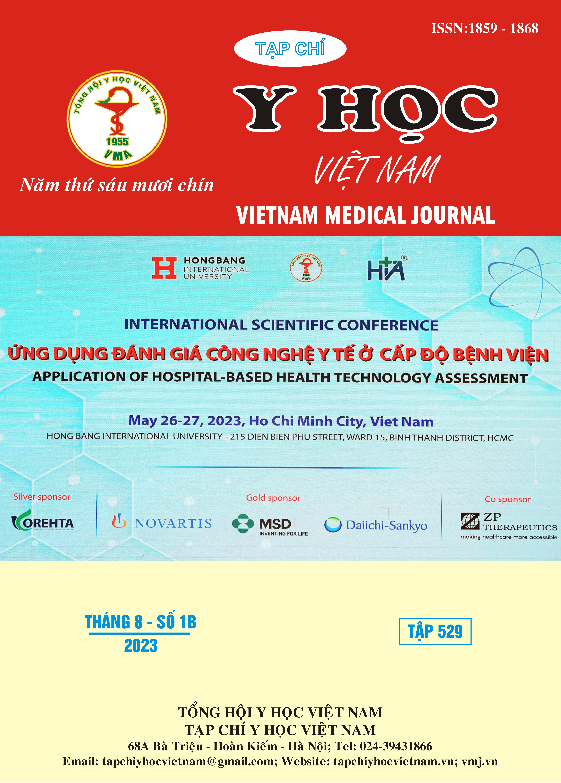MỘT SỐ YẾU TỐ LIÊN QUAN TỚI KẾT QUẢ ĐIỀU TRỊ NHỒI MÁU NÃO CẤP HỆ TUẦN HOÀN TRƯỚC BẰNG ALTEPLASE KẾT HỢP LẤY HUYẾT KHỐI CƠ HỌC
Nội dung chính của bài viết
Tóm tắt
Mục tiêu: Xác định tỷ lệ kết quả điều trị tốt, mRS 0-2 ở ngày thứ 90,và một số yếu tố liên quan ở nhóm bệnh nhân nhồi máu não cấp hệ tuần hoàn trước điều trị bằng Alteplase liều 0.9mg/kg kết hợp lấy huyết khối cơ học tại Bệnh viện Bạch Mai. Đối tượng và phương pháp nghiên cứu: thiết kế nghiên cứu quan sát, phân tích 35 bệnh nhân nhồi máu não cấp trong cửa sổ 4,5 giờ do tắc mạch lớn hệ tuần hoàn trước được tiêu sợi huyết và lấy huyết khối cơ học tại Bệnh viện Bạch Mai giai đoạn 2018 – 2020. Kết quả: Nghiên cứu thu tuyển được 35 bệnh nhân, trong đó, nam giới chiếm 59,1%. Nhóm có kết quả điều trị tốt, mRS 0-2 ngày thứ 90, chiếm 22/35 (62,9%). Một số yếu tố liên quan tới kết quả điều trị tốt là: tuổi (OR 0,91; 95%CI 0,82-0,98; p=0,04), điểm NIHSS ban đầu (OR 0,95; 95% CI 0,92-0,98; p=0,02), số lần lấy huyết khối (OR 0,62; 95%CI 0,55-0,68; p=0,03). Kết luận: Tỷ lệ bệnh nhân nhồi máu não cấp hệ tuần hoàn trước điều trị kết hợp alteplase và lấy huyết khối cơ học đạt kết quả điều trị tốt là 62,9% và một số yếu tố liên quan là tuổi, điểm NIHSS ban đầu và số lần lấy huyết khối.
Chi tiết bài viết
Từ khóa
nhồi máu não cấp, điều trị kết hợp, kết quả điều trị, một số yếu tố liên quan
Tài liệu tham khảo
2. Turc G, Bhogal P, Fischer U, et al. European Stroke Organisation (ESO) - European Society for Minimally Invasive Neurological Therapy (ESMINT) Guidelines on Mechanical Thrombectomy in Acute Ischemic Stroke. J NeuroInterventional Surg. Published online March 1, 2019. doi:10.1136/neurintsurg-2018-014569
3. Berge E, Whiteley W, Audebert H, et al. European Stroke Organisation (ESO) guidelines on intravenous thrombolysis for acute ischaemic stroke. Eur Stroke J. 2021;6(1):I-LXII. doi:10.1177/2396987321989865
4. Anh N, Luu V, Khoe L, et al. Effect of mechanical thrombectomy with vs. without intravenous thrombolysis in acute ischemic stroke. Clin Ter. 2022;173:257-264. doi:10.7417/CT.2022.2429
5. Banks JL, Marotta CA. Outcomes Validity and Reliability of the Modified Rankin Scale: Implications for Stroke Clinical Trials. Stroke. 2007;38(3):1091-1096. doi:10.1161/01.STR.0000258355.23810.c6
6. Fugate JE, Klunder AM, Kallmes DF. What Is Meant by “TICI”? AJNR Am J Neuroradiol. 2013;34(9):1792-1797. doi:10.3174/ajnr.A3496
7. Chung J, Park SH, Kim N, et al. Trial of ORG 10172 in Acute Stroke Treatment (TOAST) Classification and Vascular Territory of Ischemic Stroke Lesions Diagnosed by Diffusion‐Weighted Imaging. J Am Heart Assoc. 3(4):e001119. doi:10.1161/JAHA.114.001119
8. Mai DT, Dao VP, Nguyen VC, et al. Low-Dose vs. Standard-Dose Intravenous Alteplase in Bridging Therapy Among Patients With Acute Ischemic Stroke: Experience From a Stroke Center in Vietnam. Front Neurol. 2021;12:653820. doi:10.3389/fneur.2021.653820


